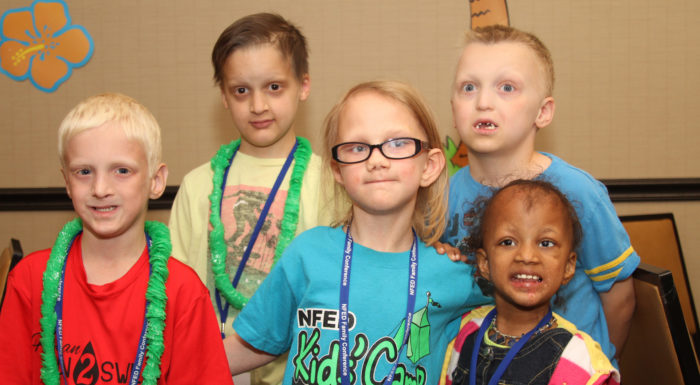
Ectodermal dysplasias are a diverse group of genetic disorders that involve defects of the hair, nails, teeth, skin and glands. Other parts of the body, such as the eyes or throat, may be affected as well. The combination of physical features a person has and the way in which it is inherited determines if it is an ectodermal dysplasia. For example, hypohidrotic ectodermal dysplasia affects the hair, teeth and sweat glands while Clouston syndrome affects the hair and nails.
More than 50 different types of ectodermal dysplasias exist. Yet, most types share some common symptoms, ranging from mild to severe. The early diagnosis of a specific type will help identify which combination of symptoms the person has or will have.
When Do Signs of Ectodermal Dysplasia Appear?
People are born with ectodermal dysplasia. Some syndromes (i.e. cleft lip and palate, missing fingers, skin erosion) are apparent at birth. For others, symptoms may not become noticeable until the baby grows.
For example, a baby born with hypohidrotic ectodermal dysplasia typically has peeling skin at birth. Yet a parent might not realize something is wrong until the baby’s teeth do not develop correctly. The parent might also notice the baby is lethargic and irritable when hot, but not realize it’s because the sweat glands don’t work correctly. Since ectodermal dysplasias are relatively rare, they can be difficult to diagnose.
What Is The Ectoderm?
Before a developing fetus is large enough to be seen, a layer of cells covers the outside of the body. This layer of cells is called the ectoderm. Typically, the hair, nails, teeth, and sweat glands derive from this layer of the developing embryo. Any of these derived cells and tissues can be affected in the ectodermal dysplasias. In some types, problems may also occur with parts of the eye, ear, or other organs and body features which develop from the ectoderm.
What Does Dysplasia Mean?
Dysplasia literally means “abnormal tissue growth.” There is an inherent abnormality in the way a particular part of the body is put together. A single part of the body may be abnormal or more than one part may be abnormal simultaneously. In the ectodermal dysplasias, if a disorder consistently involves more than one part of the body, it’s called a syndrome.
What Does Ectodermal Dysplasia Look Like?
This depends on the specific type of ectodermal dysplasia a person has. Even within each type, people can be affected differently depending on the combination of symptoms they have. Any one of the abnormalities may be mild or severe. The physical appearance, then, varies from person to person including within a family and from family to family. You can find photos of individuals with several of the more common types of ectodermal dysplasias in our syndrome descriptions.
The ectodermal dysplasias are complex. We are working with the scientific and medical community to create a new classification system to better define what is and what isn’t an ectodermal dysplasia. This system will include symptoms, genomic information and bio-medical information.
Learn 14 things you didn’t know about ectodermal dysplasias.
Ectodermal Dysplasia FAQs
Are ectodermal dysplasias hereditary?
All ectodermal dysplasias are genetic disorders caused by changes or mutations to the affected individual’s DNA. They are typically passed down from parent to child or sometimes appear as a new mutation in the affected individuals DNA. The different types of ectodermal dysplasias have specific inheritance patterns which affect the odds of someone’s children inheriting the syndrome Some types of ectodermal dysplasias are inherited in an autosomal dominant pattern, which means that only one copy of the mutated gene is needed to cause the condition. Click to learn more about the genetics and heritance of ectodermal dysplasias.
What parts of the body does ectodermal dysplasia affect?
Ectodermal dysplasias are a group of genetic conditions that primarily affect the skin, hair, nails, teeth, and sweat glands. Depending on the specific type and severity of the condition, symptoms may include abnormal teeth, sparse or absent hair, dry skin, decreased sweating, abnormal nails, hearing loss, and other issues. The effects of ectodermal dysplasia may also cause secondary issues like eye problems, respiratory system issues, gastrointestinal issues and more.
Are ectodermal dysplasias more common in males or females?
Ectodermal dysplasia affects males and females equally. The inheritance pattern, or how it is passed from parent to child, of ectodermal dysplasia depends on the specific type of the condition. Some types are inherited in an X-linked recessive pattern, which means that the condition is caused by changes in genes on the X chromosome and typically affect males more severely than females. Other types of ectodermal dysplasia are inherited in an autosomal dominant or autosomal recessive pattern, which means that the condition can affect both males and females equally.